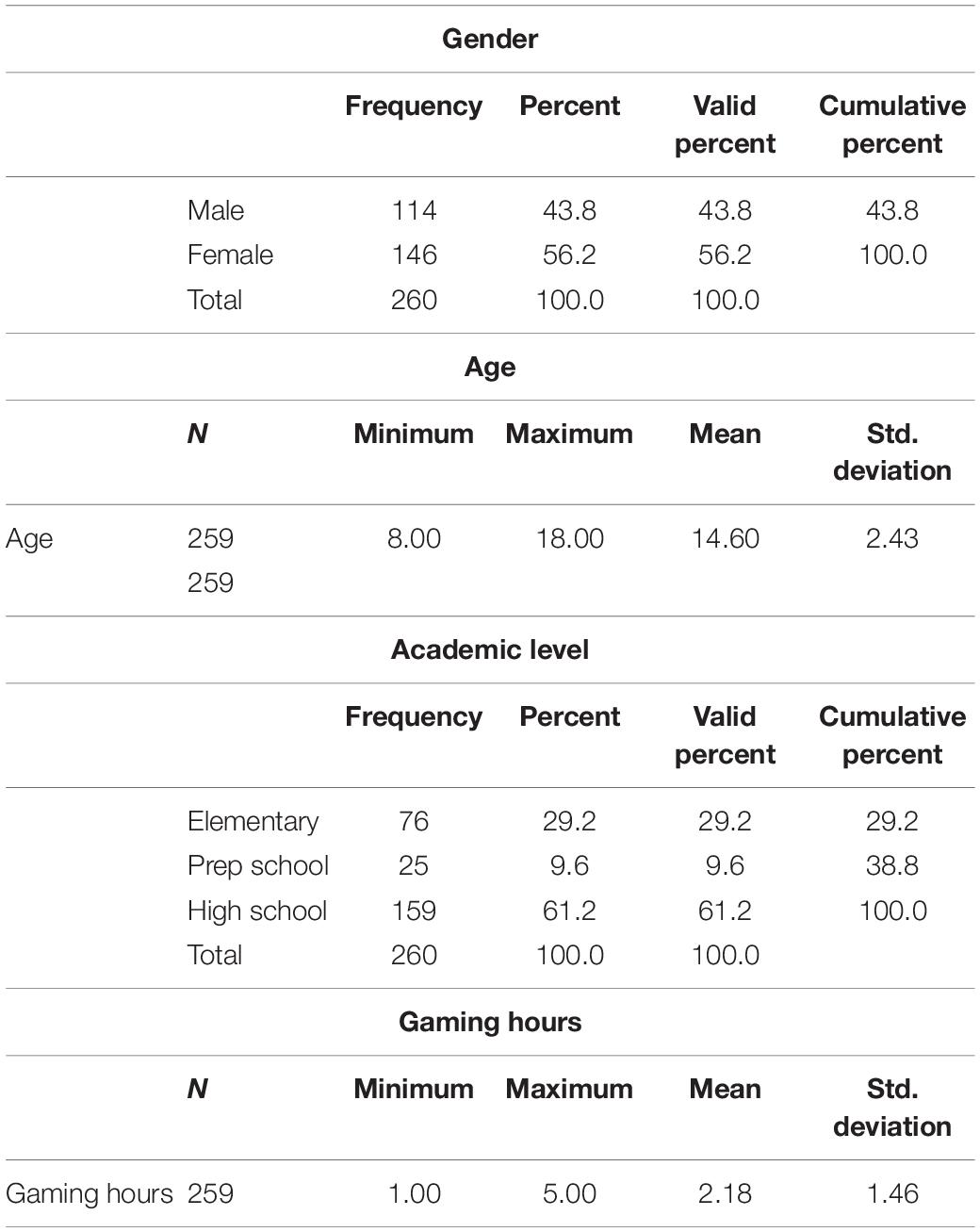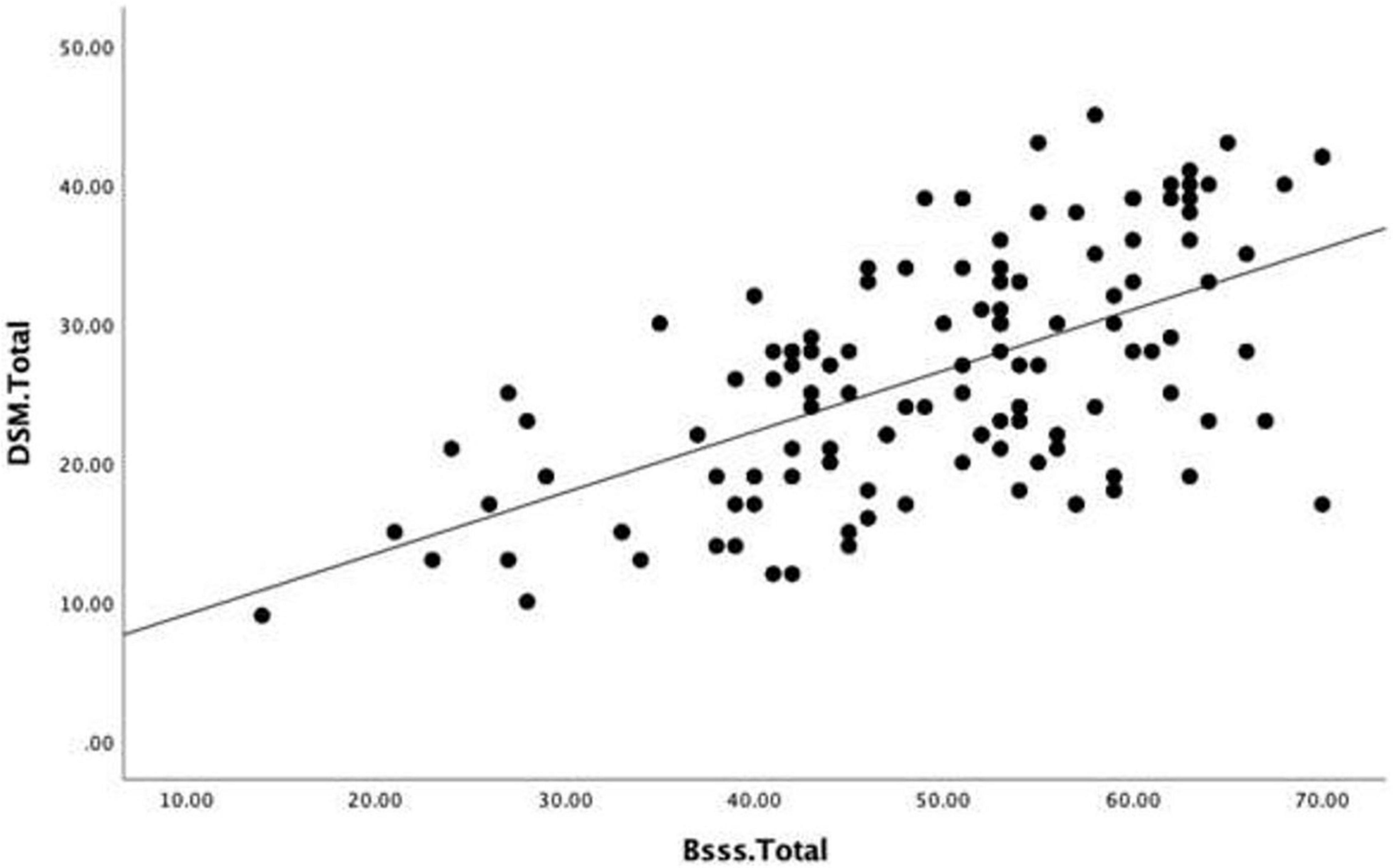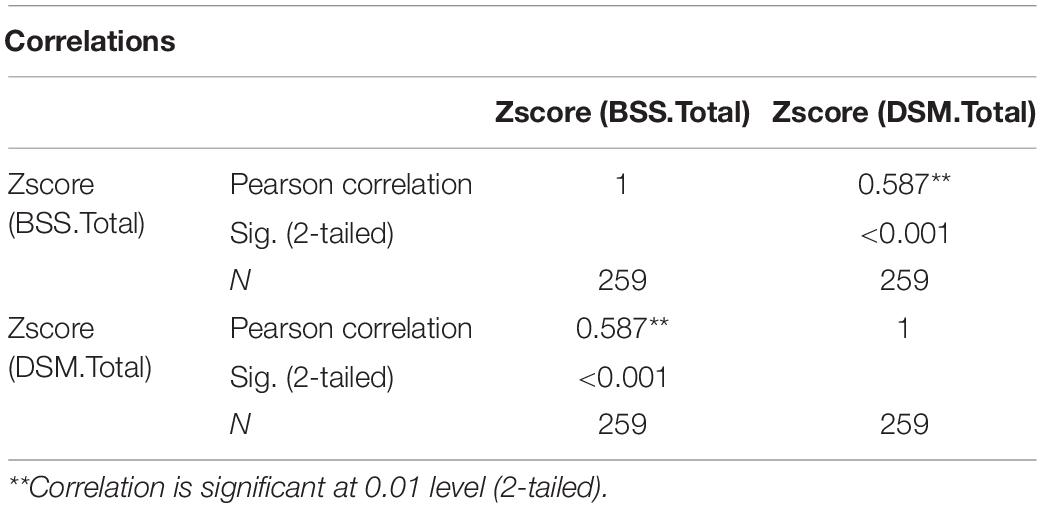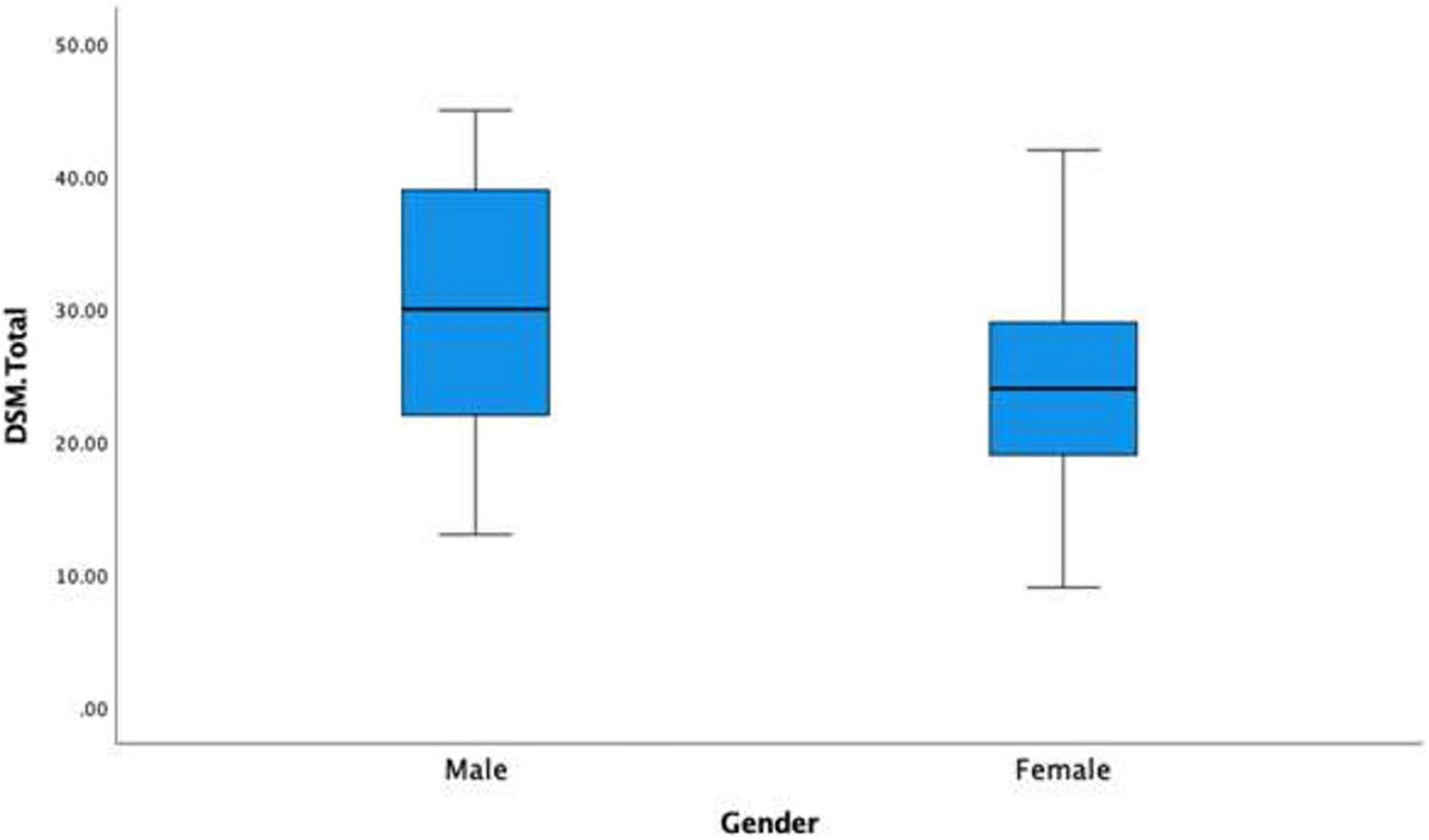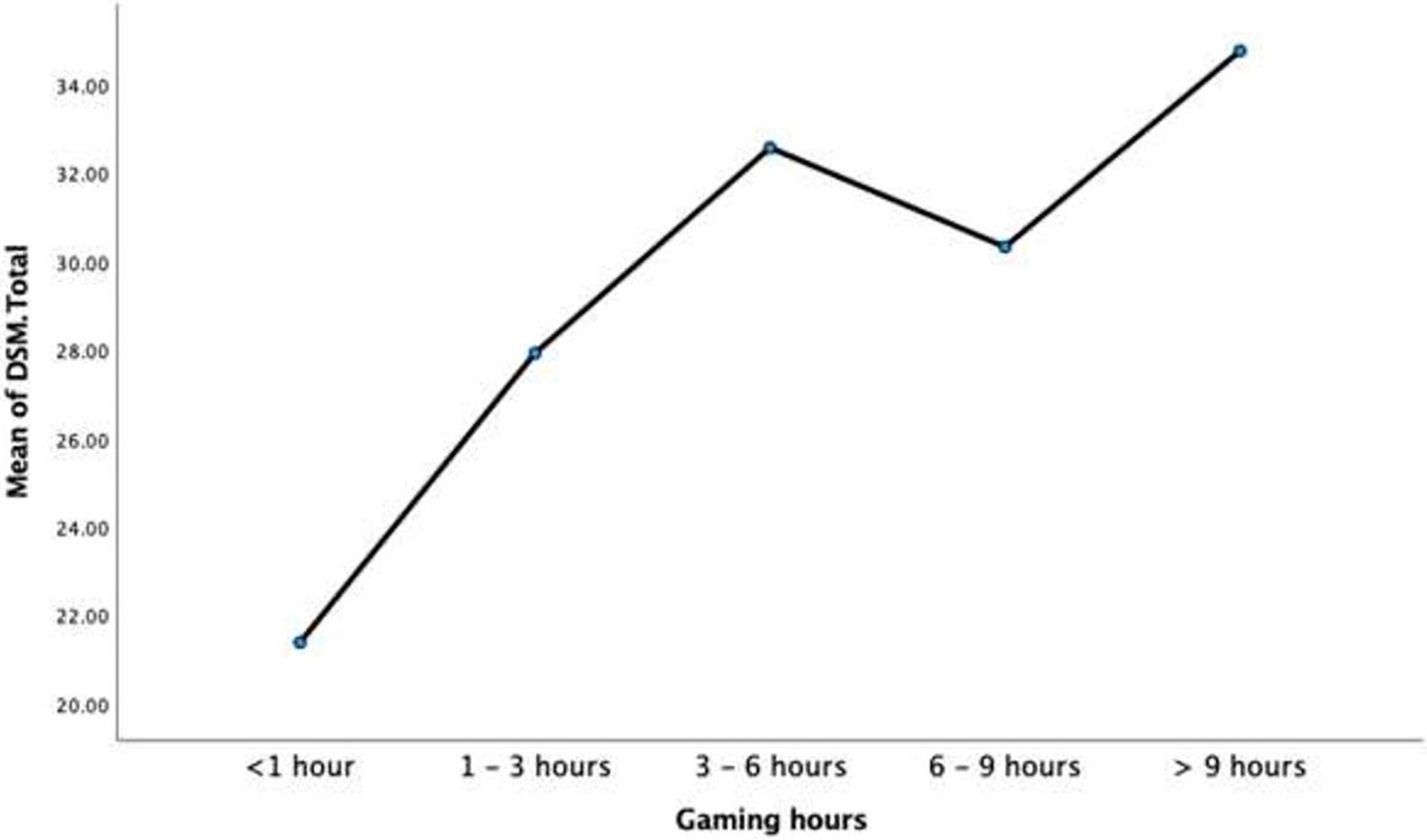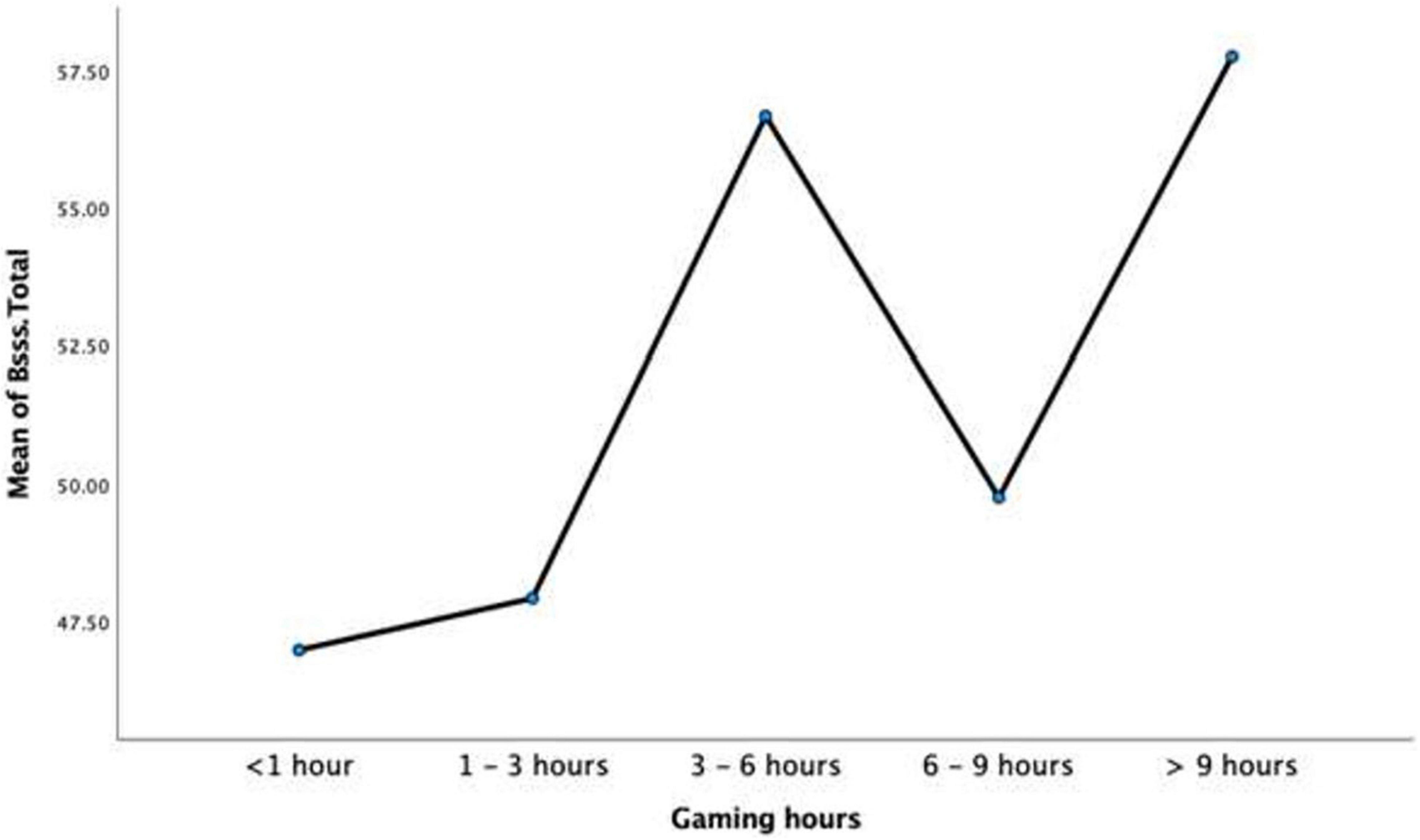- 1Faculty of Education, Ain Shams University, Cairo, Egypt
- 2College of Humanities and Sciences, Ajman University, Ajman, United Arab Emirates
- 3Faculty of Education, Tanta University, Tanta, Egypt
- 4School of Social Sciences, Nottingham Trent University, Nottingham, United Kingdom
- 5Department of Psychological Sciences, Qatar University, Doha, Qatar
Research on internet gaming disorder (IGD) has increased considerably over the last decade. Although most IGD research has focused on Western or South Asian samples, it is critical to understand and assess this disorder among other populations. The present study investigated the association between IGD and sensation seeking among Arab adolescents. An online survey consisting of the short internet gaming disorder short scale (IGDSS) and brief sensation seeking scale (B-SSS) was completed by 260 participants (mean age = 14.61, SD = 2.43). The results showed that sensation seeking behaviours were associated with higher gaming hours and greater chances of exhibiting IGD. The findings support the current perspective of understanding this disorder from a disease framework as it highlights the relevance of behavioural components in gaming addiction. Importantly, the results will further aid the development of reliable diagnosis and efficacious treatments within clinical practices.
Introduction
Online gaming is a popular leisure activity for millions of people around the world because it provides an environment where individuals can form new relationships, adopt new online personas and escape from reality (1). Gaming can be a beneficial activity as it improves integration of perceptual information into the brain and hand-eye coordination (2). However, for some it may lead to problematic use as excessive gaming can result in a loss of impulse control, behavioural inhibition, executive functioning and attention (1, 3). As the internet has evolved and become a dominant part of life, problems associated with internet use have increased. Some researchers have suggested that gaming behaviour that is characterised as being excessive, maladaptive, and repetitive relates very closely to substance addiction (4, 5) and can therefore be characterised as a behavioural addiction. The term behavioural addictions is now recognised by many researchers. Various types of behavioural addictions have been studied, including internet addiction (IA) (6), smartphone addiction (7, 8), social networking addiction (9), and pathological gambling (10). Researchers have argued that all of these online activities can be addictive and can negatively affect the user’s mental health (11–13). Despite there being consensus on the criteria of maladaptive online gaming, the aetiology of this addiction has yet to be studied in detail. Personality traits such as neuroticism, aggression, hostility and sensation seeking have been suggested as risk factors (14).
Several terms have been used to describe problematic gaming behaviour. These include internet gaming disorder (IGD), computer game addiction, video game addiction, game overuse, and pathological internet use. More recent research studies have used the term IGD (15, 16). It is important to note that IGD is not yet considered a clinical disorder in the fifth edition of the Diagnostic and Statistical Manual of Mental Disorders [DSM-5; (17)], further research into the behaviour was encouraged. The DSM-5 clearly defined symptom criteria for IGD, one must display five or more diagnostic criteria during a 12 month period. The criteria include evidence of (1) preoccupation with games, (2) withdrawal symptoms, (3) the need to spend increasing amounts of time engaged with games (tolerance), (4) unsuccessful attempts to control or reduce game play, (5) loss of interest in real-life relationships, hobbies, and other entertainment, (6) continued excessive use of games despite knowledge of psychosocial problems, (7) deception of others regarding amount of gaming, (8) use of games to relieve a negative mood, and (9) jeopardising or losing a significant relationship, job, or educational opportunity because of gaming. This criterion has been used increasingly by researchers to investigate problematic gaming behaviour.
As research continues to be conducted into problematic behaviours, concerns about the impact of IGD on the lives of gamers has led to an increase in research studies that highlight potential negative effects. Ohayon et al. (18) investigated IGD among United States university students. The results showed that IGD was prevalent in 5.3% of the sample, IGD was associated with non-restorative sleep, excessive daytime fatigue, depressive mood, and social anxiety disorder. A range of other predictors of IGD have been reported in research, these include procrastination (19), alexithymia, depression, and anxiety (20, 21), physical and psychological harm (22), and emotional problems (23). Some studies have investigated variables that may be seen as risk factors and that may predict IGD. For example, Rho et al. (24) reported that the risk factors of functional and dysfunctional impulsivity, self-control, anxiety, pursuit of desired appetitive goals, money spent on gaming, weekday game time, offline community meeting attendance, and game community membership were significantly associated with IGD. Müller et al. (25) reported that higher neuroticism, decreased conscientiousness, and low extraversion were associated with IGD. Fumero et al. (26) found that anxiety, time spent playing predicted IGD, social skills and family functioning indirectly predicted IGD. The researchers also found that a different set of variables was associated with IGD depending on gender; lower family functioning was associated with IGD in females, hostility and social skills deficit was associated with IGD in males. One study reported that impulsiveness and high amounts of time gaming may be risk factors for IGD (27). Altogether, research studies have shown that there are numerous variables or risk factors associated with IGD.
There are several theories that have proven useful in understanding the mechanisms underlying the phenomenon of IGD. The cognitive-behavioural model of IGD (28, 29) focuses on the role of three domains in addictive behaviour; (1) motivational drives related to reward-seeking and stress-reduction, (2) behavioural control relating to executive inhibition, and (3) decision-making that weighs the consequences of engaging in motivated behaviours. The Compensatory internet use model (30) proposes that conclusion can be drawn by understanding motivations and how they mediate the relationship between psychosocial wellbeing and problematic internet use. Recently, the interaction of person-affect-cognition-execution (I-PACE) model (31) describes how the interaction between predisposing variables (e.g., psychopathological variables, interpersonal sensitivity) and cognitive and affective mechanisms could result in the loss of control and then consequently lead to IGD. Taken together, theories of addictive behaviour have proven useful in explaining and understanding IGD and related behaviours.
Given the theoretical approaches and the discussion of predisposing variables, one variable that has been discussed and associated with high risk and addictive behaviours is sensation seeking [SS; (32–34)]. Research studies have reported associations between sensation seeking and severity of internet risk (35): Floros et al. (36) reported elevated SS among IA treatment seekers, Nejadfard and Hosseinsabet (37) reported significant associations between SS and IA. However, contrary to these research findings, inconsistent results have also been reported; Müller et al. (38) found decreased SS in patients with IA, a meta-analysis concluded that there were no signs of higher SS in gambling disorder [GD; (39)], also, no relationships between GD and SS have been reported (40). High sensation seekers prefer sensations that are varied, novel, and complex (41). Online games include all of these features and game companies are always developing new versions of games that contain advanced graphics and rich audio and visual effects. Research findings are inconsistent on the issue of sensation seeking, further examination is required.
Previous research has examined IGD among samples in western and Asian cultures identifying problems with dealing with Internet use (42). There is a lack of research literature that investigates IGD amongst the Arab population, studying this behaviour among this culture would provide unique and interesting insights. The present study sought to further understand IGD and sensation seeking using an online survey method. The focus of the study was on Arab adolescents, this is important because internet penetration rates have greatly increased among populations from the Middle East and North Africa (43). Little is known about the make-up of gamers from Arab countries, therefore an exploration of gaming, IGD, and variables that are associated with gaming is warranted. Previous IGD research among non-Arab gamers have reported interesting findings in regards to gender, education level, and gaming time (44–47). Little is known about these variables and how they may be associated with IGD among Arab gamers. The aims of the current study were to examine IGD and its potential associations with sensation seeking, gender, time spent gaming, and education level among a sample of Arab adolescents. IGD prevalence rates were also examined.
Materials and Methods
Participants
There were 260 participants in this study that consisted of 56.2% females ranging between the ages of 8 and 18, (Mean age = 14.61, SD = 2.43). Most participants were in high school (61.2%), followed by elementary level (29.2%), and finally prep school (9.5%). It was found that most of the participants (44.6%) played video games up to an hour per day, while 21.6% played between 1 and 3 h a day, 14.6% played between 3 and 6 h per day, while the remaining 19.2% played 6 h or more a day. Table 1 shows the participants’ characteristics.
Ethics
The study was approved by the ethics committee of the research team’s university. The study was carried out in accordance with the Declaration of Helsinki. All participants were informed about the study and all provided informed consent.
Design and Materials
A cross-sectional online survey design was utilised in the present study. An online survey was developed with the use of Qualtrics Survey Software. The survey comprised of demographic questions and questions regarding the participants’ education level. The survey also comprised of a measure online gaming time and psychological instruments to assess the associations between IGD severity and sensation seeking, these instruments are described below.
The Internet Gaming Disorder Short Scale
The Internet Gaming Disorder Short Scale [IGDSS; (48)] is a tool used to assess the severity of the diagnostic and statistical manual of mental disorders (DSM) symptoms in online gamers over 12 months. The scale consists of 9 items answered on a 5-point Likert scale. The total score of items range from 9 to 45, with higher scores indicating greater severity in IGD symptomology (see Figure 1). The IGDSS has good psychometric properties in Arab contexts (α = 0.856) which was supported with exploratory and confirmatory Factor Analysis.
The Brief Sensation Seeking Scale
The Brief Sensation Seeking Scale [B-SSS; (48)] is adapted from the Form V of the Sensation Seeking Scale [SSS-V; (49)] and tailored for Arab speaking adolescents. It has been validated in Arab populations with good psychometric properties (α = 0.882). The Arabic version consist of 14 items answered on a five-point Likert scale (strongly agree to strongly disagree) and based on four factors: thrill and adventure seeking, disinhibition, experience seeking, and boredom susceptibility.
Time Spent Online Gaming
Time spent online gaming was measured by asking participants to state how many minutes they spent online gaming each day.
Procedure
A recruitment message was posted online and sent via email to students inviting them to participate in the study. The recruitment message included information about the purpose of the study. When participants began the survey, they were presented with a participant information page followed by clear instructions on how to complete the survey. All participants were assured that their data would remain anonymous and confidential. A debriefing statement at the end of the survey reiterated the purpose of the study and informed participants of their right to withdraw from the study.
Statistical Analysis
Descriptive statistics for the scales (mean scores, standard deviations, Cronbach’s alpha), Pearson’s correlation coefficients, linear regression, t-tests, and multivariate analysis of variance (MANOVA) were calculated using IBM SPSS for Windows, version 26.0. The significance limit was set at p < 0.05.
Results
A bivariate correlation was conducted to evaluate whether higher scores on the Sensation Seeking Scale (B-SSS) would correlate with higher scores on the Internet Gaming Disorder (IGDSS). To assess the size and direction of the linear relationship between both scores, a bivariate Pearson’s product-moment correlation coefficient (r) was calculated. The bivariate correlation was positive and strong, r(257) = 0.587, p < 0.001. A calculation of r2 showed that 34.5% of variance in participants’ IGD scores can be explained by the variability in SS scores (see Table 2).
The linear regression equation for predicting the IGD is
This equation indicates that the relationship between both variables was linear and heteroscedastic. In addition, for every unit increase in SS, it was predicted that IGD would increase by 0.44.
An independent samples t test was carried out to compare average SS scores reported by male participants (n = 114) to the average SS scores reported by females (n = 145). Levene’s test was not significant (p = 0.749), therefore equal variance was assumed. The t test was statistically significant, with the male cohort reporting (M = 51.65, SD = 11.60) on average 3.06 units higher on SS, 95% CI [0.277, 5.85], than female participants (M = 48.58, SD = 11.06), t(257) = 2.165, p = 0.031, d = 0.27 (see Table 3).

Table 3. Means, standard deviations, and t-test for equality of means of sensation-seeking (SS) according to gender.
There was interest in whether there would be a significant gender difference in IGD scores. To this end, an independent samples t-test was conducted to answer this question. The results indicate that the Levene’s test was significant (p < 0.001) which meant equal variance could not be assumed (see Figure 2 boxplot for heterogeneity of variance) as males had considerably higher variance in their scores. The t test for equal variances not assumed was statistically significant, with the male group (M = 29.45, SD = 9.23) reporting on average 5.11 units higher on IGD scores compared to the female group (M = 24.34, SD = 7.14), 95% CI [3.04,7.18], t(208.19) = 4.87, p < 0.001, d = 0.63.
A secondary analysis was implemented to analyse those participants who exhibited high IGD scores and therefore met the DSM-5 criteria for IGD (responding strongly agree for at least 5 out of 9 symptoms). The descriptive statistics found that the prevalence rate of high IGD (renamed IGD_Clinical) scores in the present sample was 6.2% (n = 16) (see Table 4).

Table 4. Means, standard deviations, and t-test for equality of means of IGD.Total according to gender.
Based on this new clinical group (IGD_Clinical), an independent samples t-test was conducted to evaluate whether there would be a significant difference between respondents in IGD_Clinical (n = 16) and non-clinical on Sensation Seeking scores (n = 243) (see Table 5). Levene’s test was not significant, therefore equal variances was assumed. The t test was significant, with the IGD_Clinical (M = 62.25, SD = 7.37) reporting on average 13.13 points higher on Sensation Seeking scores (B-SSS), CI 95% [7.56,18.69], than the sub-clinical group (M = 49.12, SD = 11.14), t(257) = 4.64, p < 0.001, d = 1.2 (see Table 6).
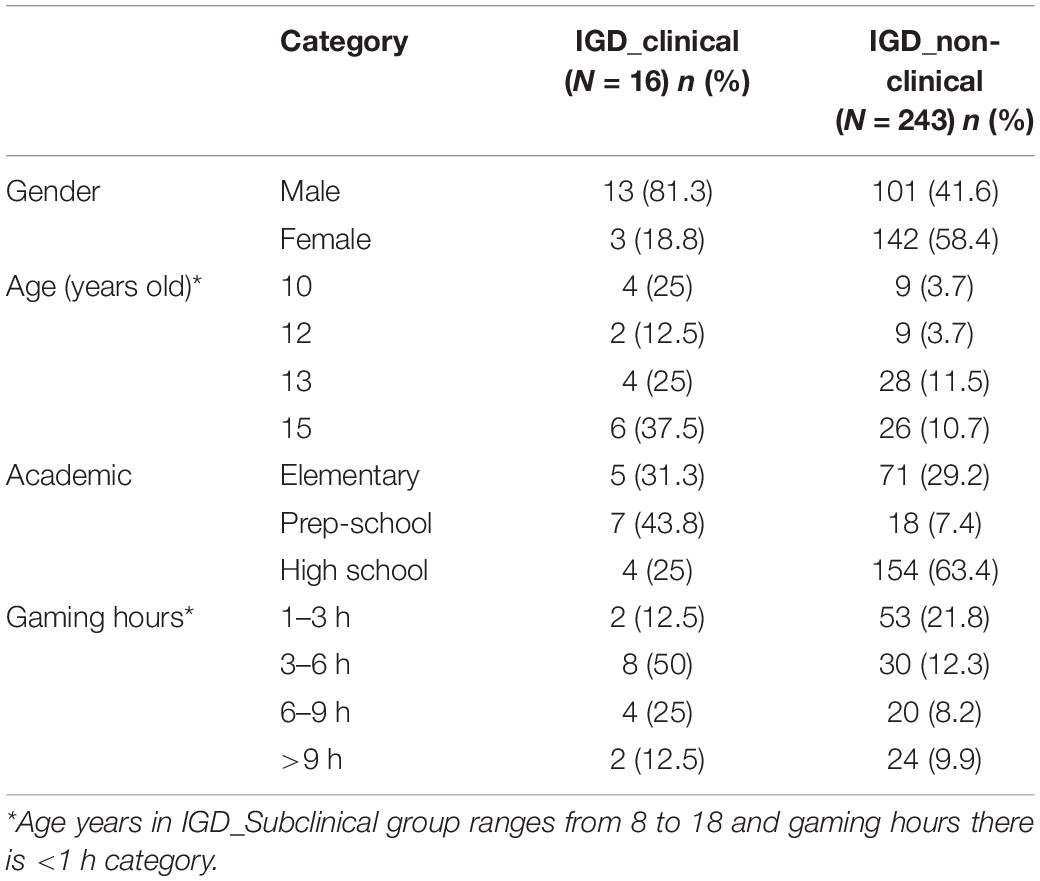
Table 5. Summary of percentages of IGD_clinical compared to IGD_non-clinical on gender, age, academic, and gaming hours.

Table 6. Means, standard deviations, and t-test for equality of means of SS scores according to clinical and non-clinical internet gaming disorder (IGD) scores.
Another research question of interest was whether participants’ grade level significantly affected their scores on SS and IGD. To this end, a one-way MANOVA was conducted to determine the effect of school grades (elementary, prep-, and high-school) on the two dependent variables, SS and IGD. As all underlying assumptions were supported by the data, a MANOVA was conducted. Findings showed that there was a significant effect of education level on SS and IGD levels, F(4,510) = 5.15, p < 0.001, partial η2 = 0.039.
Analysis of the dependent variables individually showed no effect of SS scores as a function school level. However, the IGD scores were statistically significant at a Bonferroni adjusted alpha level of 0.025, F(2,256) = 8.75, p = <0.001, partial η2 = 0.064. This indicated that scores on IGD significantly differed as a function of school grade (see Table 7).
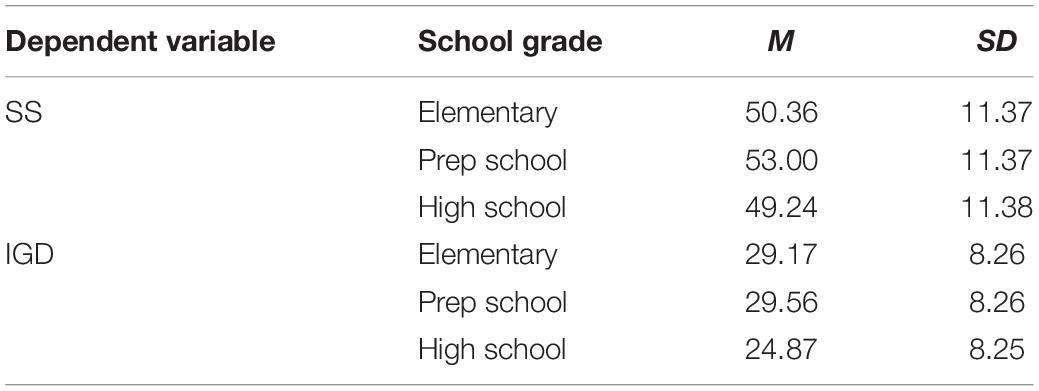
Table 7. Post hoc analysis of univariate analysis of variance (ANOVA) for internet gaming disorder (IGD).
Table 8 shows the descriptive statistics for elementary (n = 76), prep school (n = 25), and high school (n = 158) on each dependent variable.
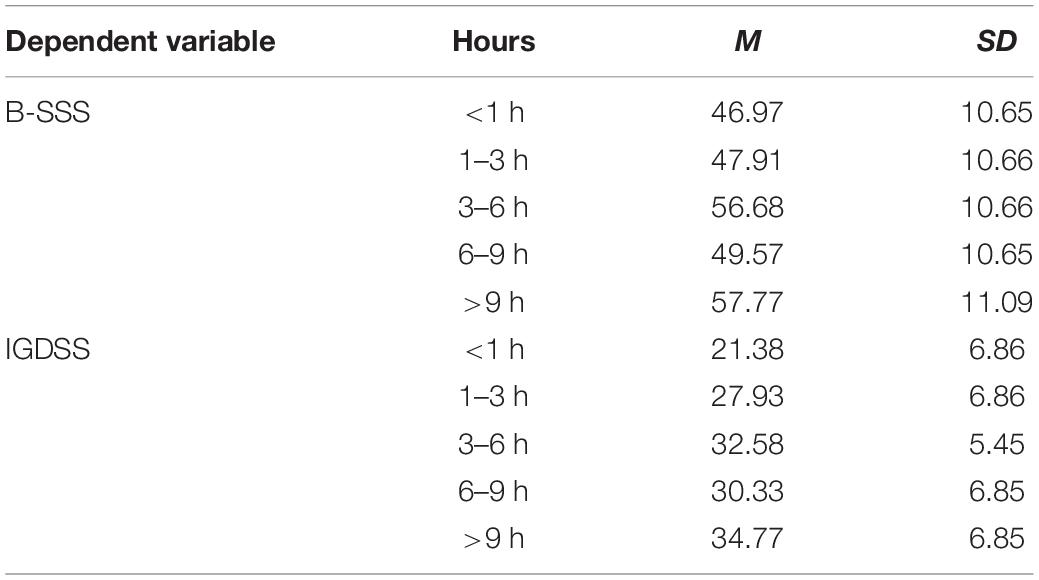
Table 8. Post hoc analysis of univariate analysis of variance (ANOVA) for internet gaming disorder short scale (IGDSS).
Post hoc analysis of univariate analysis of variance (ANOVA) for IGD scores was conducted to ascertain which school grades differed significantly on IGD scores. Based on Tukey HSD pairwise comparisons, high school scores were significantly lower than elementary (M difference = −4.30, p < 0.001) and prep school (M difference = −4.69, p = 0.024). No significant differences were found between elementary and prep school IGDSS scores (see Figure 4).
A further research question of interest was the extent to which the amount of gaming hours would produce significantly different scores on Sensation Seeking and IGD. To this end, a one-way MANOVA was conducted to ascertain levels of IGDSS and B-SSS as a function of the number of hours’ participants played online games. As all underlying assumptions were supported by the data, a MANOVA was conducted. Findings showed that there was a significant effect of number of hours (<1, 1–3, 3–6, 6–9, and >9 h) on scores on IGDSS and B-SSS scores, F(8,506) = 17.85, p < 0.001, partial η2 = 0.220.
Analysis of the dependent variables individually showed significant difference as a function of hours played. B-SSS scores were statistically significant at a Bonferroni adjusted alpha of 0.025, F(4,254) = 10.08, p < 0.001, partial η2 = 0.137. Similarly, IGDSS scores differed significantly at a Bonferroni adjusted alpha of 0.025, F(4,254) = 35.52, p < 0.001, partial η2 = 0.359 (see Table 8).
Table 8 shows the descriptive statistics for <1 h (n = 116), 1–3 h (n = 55), 3–6 h (n = 38), 6–9 h (n = 24), and >9 h (n = 26) on each dependent variable.
Post hoc analysis of univariate ANOVA for IGDSS scores was conducted to ascertain what hour groups differed significantly between each other on gaming disorder scores. Based on Tukey HSD pairwise comparisons, it was found that participants in the <1 h group had significantly lower IGDSS scores compared to 1–3 h (M difference = −6.55, p < 0.001), 3–6 h (M difference = −11.20, p < 0.001), 6–9 h (M difference = −8.95, p < 0.001), and >9 h (M difference = −13.39, p < 0.001). Furthermore, 1–3 h group was significantly lower than 3–6 h (M difference = −4.65, p = 0.013) and >9 h (M difference = −6.84, p < 0.001), but not of 6–9 h. In addition, 3–6 h group was not significantly higher nor lower than 6–9 h and >9 h groups. Finally, >9 h was significantly greater than <1 h and 1–3 h, but not 3–6 and 6–9 h (see Figure 5).
A second post hoc analysis of univariate ANOVA for B-SSS scores was carried out to verify if sensation seeking scores differed significantly between hour groups. Based on Tukey HSD pairwise comparisons, it was found that those in the <1 h group showed significantly less B-SSS scores than 3–6 h (M difference = −9.72, p < 0.001) and >9 h (M difference = −10.80, p < 0.001), but not 1–3 h nor 6–9 h. Furthermore, 1–3 h was significantly less than 3–6 h (M difference = −8.78, p = 0.001) and >9 h (M difference = −9.86, p = 0.001). Finally, the 6–9 h group was not significantly different to any other hour group (see Figure 6).
Discussion
The present study investigated IGD and associations with sensation seeking in a sample of Arab adolescents. This study is one of a very small number of studies to examine IGD amongst an Egyptian sample. The results showed that there was a significant positive association between SS and IGD; as SS scores increased, IGD severity scores also increased. This is in accordance with past research (35, 36, 50–54). Furthermore, SS scores explained a substantial amount of variance in IGD severity scores. On average, male participants displayed higher SS scores and higher IGD severity scores than female participants, this is in accordance with previous research (55, 56).
The results also revealed that the clinical IGD severity prevalence rate was 6.2%, this was higher than prevalence rates reported in a German sample [3.5%, (56)], and in a Chinese sample [4.3%, (57)]. When comparing the clinical IGD severity and non-clinical IGD severity group, the results showed that the clinical IGD severity group reported higher SS scores than the non-clinical IGD severity group (see Figure 3). Similar findings were reported by previous research studies (36, 37). Furthermore, analysis of time spent online gaming revealed that playing for less than 1 h a day was associated with significantly lower IGD severity scores, playing for more than 3 h was associated with significantly higher IGD severity scores. These findings support previous research that has reported associations between increased time playing and IGD (16, 26, 27, 46).
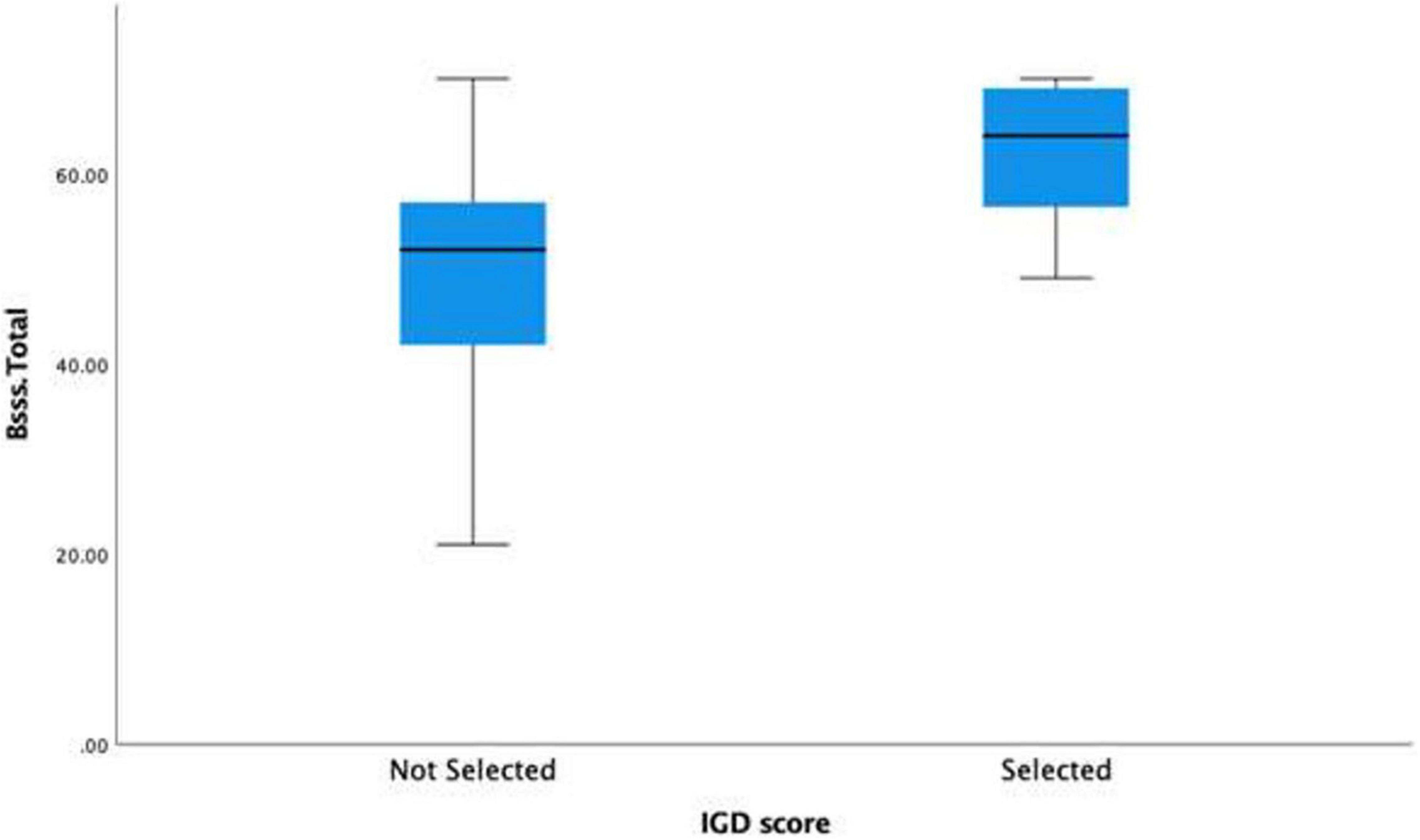
Figure 3. Boxplot of the means and SDs of sensation seeking disorder based on clinical (selected) and non-clinical (not selected) internet gaming disorder (IGD) scores.
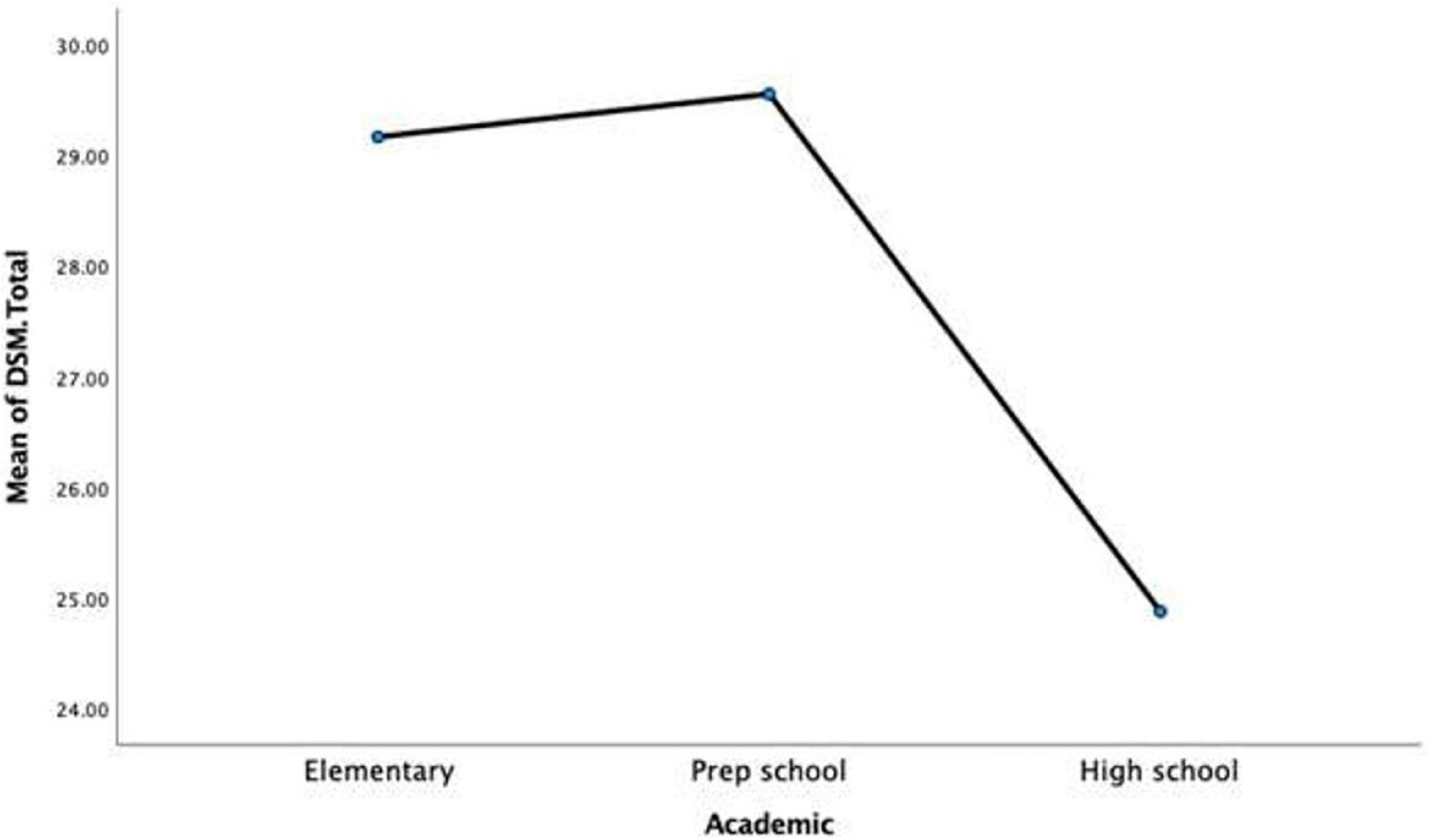
Figure 4. Mean internet gaming disorder short scale (IGDSS) scores on elementary, prep school, and high school grades.
In regards to SS, playing for less than an hour or between 1 and 3 h was associated with significantly lower SS scores. This finding contributes to the research literature by revealing that lower amounts of time gaming can be a buffer against the need to use online gaming as a sensation seeking experience. It can be speculated that the desire to experience arousing feelings may be associated with increased gaming time. The cognitive-behavioural model of IGD (28) can be applied here, gamers may begin to engage in gaming for reward-seeking and stress-reduction purposes, then later make a decision to stop playing after weighing up the consequences of excessive playing. Gamers may be implementing behavioural control mechanisms, further research studies that examine the decision making processes of gamers is needed.
While this study provides important insights into the online gaming behaviour of Arab adolescents and sensation seeking, the study has some limitations. The recruitment of a non-clinical sample meant that the generalisability of the findings was reduced. The use of self-report methods meant that the effects of recall bias could not be excluded. Future research should attempt to tackle these limitations. Furthermore, future research could investigate family relationships as a potential factor associated with IGD, research has reported that poor quality parent-child relationships are associated with increased IGD severity (58). Longitudinal and intervention studies are needed to help improve understanding and provide treatment.
The present study is an important step towards understanding IGD and SS. The study found associations between SS and IGD, higher SS scores were reported among the clinical IGD severity group, and male participants reported higher SS and IGD severity scores. The study findings provided important insights into an under-researched culture and will have implications for the development of interventions.
Data Availability Statement
The original contributions presented in this study are included in the article/Supplementary Material, further inquiries can be directed to the corresponding author.
Author Contributions
MH came up with the idea for the study. ZH helped come up with the plan for the study. EA did the testing and data collection. MH analyzed and interpreted the data under the direction of AA and EA wrote the manuscript. AA and ZH made important changes and gave the reviewers’ corrections. All authors agreed that the final version of the manuscript was ready to be sent out and agreed that they all made equal contributions to this manuscript.
Conflict of Interest
The authors declare that the research was conducted in the absence of any commercial or financial relationships that could be construed as a potential conflict of interest.
Publisher’s Note
All claims expressed in this article are solely those of the authors and do not necessarily represent those of their affiliated organizations, or those of the publisher, the editors and the reviewers. Any product that may be evaluated in this article, or claim that may be made by its manufacturer, is not guaranteed or endorsed by the publisher.
Supplementary Material
The Supplementary Material for this article can be found online at: https://www.frontiersin.org/articles/10.3389/fpsyt.2022.905553/full#supplementary-material
References
1. Kuss DJ. Internet gaming addiction: current perspectives. Psychol Res Behav Manag. (2013) 6:125–37. doi: 10.2147/PRBM.S39476
2. Liu J, Gao XP, Osunde I, Li X, Zhou SK, Zheng HR, et al. Increased regional homogeneity in internet addiction disorder: a resting state of functional magnetic resonance imaging study. Chin Med J. (2010) 123:1904–8.
3. Paulus FW, Ohmann S, Von Gontard A, Popow C. Internet gaming disorder in children and adolescents: a systematic review. Dev Med Child Neurol. (2018) 60:645–59. doi: 10.1111/dmcn.13754
4. Griffiths M. Behavioural addiction: an issue for everybody? Employee Counselling Today (1996) 8:19–25. doi: 10.1108/13665629610116872
5. Griffiths MD. Behavioural addiction and substance addiction should be defined by their similarities not their dissimilarities. Addiction (2017) 112:1718–20. doi: 10.1111/add.13828
6. Błachnio A, Przepiorka A, Senol-Durak E, Durak M, Sherstyuk L. The role of personality traits in Facebook and Internet addictions: a study on Polish, Turkish, and Ukrainian samples. Comput Hum Behav. (2017) 68:269–75. doi: 10.1016/j.chb.2016.11.037
7. Haug S, Castro RP, Kwon M, Filler A, Kowatsch T, Schaub MP. Smartphone use and smartphone addiction among young people in Switzerland. J Behav Addict. (2015) 4:299–307. doi: 10.1556/2006.4.2015.037
8. Pearson C, Hussain Z. Smartphone use, addiction, narcissism, and personality: a mixed methods investigation. In: IGI Global editor. Gaming and Technology Addiction: Breakthroughs in Research and Practice. Hershey, PA: IGI Global (2017). p. 212–29. doi: 10.4018/ijcbpl.2015010102
9. Monacis L, De Palo V, Griffiths MD, Sinatra M. Social networking addiction, attachment style, and validation of the Italian version of the bergen social media addiction scale. J Behav Addict. (2017) 6:178–86. doi: 10.1556/2006.6.2017.023
10. Bonnaire C, Barrault S, Aïte A, Cassotti M, Moutier S, Varescon I. Relationship between pathological gambling, alexithymia, and gambling type. Am J Addict. (2017) 26:152–60. doi: 10.1111/ajad.12506
11. Diomidous M, Chardalias K, Magita A, Koutonias P, Panagiotopoulou P, Mantas J. Social and psychological effects of the internet use. Acta Inf Med. (2016) 24:66–8. doi: 10.5455/aim.2016.24.66-68
12. Hassan T, Alam MM, Wahab A, Hawlader MD. Prevalence and associated factors of internet addiction among young adults in Bangladesh. J Egypt Public Health Assoc. (2020) 95:3. doi: 10.1186/s42506-019-0032-7
13. Hussain Z, Griffiths MD. Problematic social networking site use and comorbid psychiatric disorders: a systematic review of recent large-scale studies. Front Psychiatry. (2018) 9:686. doi: 10.3389/fpsyt.2018.00686
14. Kuss DJ, Griffiths MD. Internet gaming addiction: a systemic review of empirical research. Int J Ment Health Addict. (2012) 10:278–96. doi: 10.1007/s11469-011-9318-5
15. Su B, Yu C, Zhang W, Su Q, Zhu J, Jiang Y. Father–child longitudinal relationship: parental monitoring and Internet gaming disorder in Chinese adolescents. Front Psychol. (2018) 9:95. doi: 10.3389/fpsyg.2018.00095
16. Torres-Rodríguez A, Griffiths MD, Carbonell X, Oberst U. Internet gaming disorder in adolescence: psychological characteristics of a clinical sample. J Behav Addict. (2018) 7:707–18. doi: 10.1556/2006.7.2018.75
17. American Psychiatric Association. Diagnostic and Statistical Manual of Mental Disorders. 5th ed. Arlington, VA: Author (2013).
18. Ohayon MM, Roberts L, Sullivan SS. Internet gaming disorder and comorbidities among campus-dwelling US University students. Psychiatry Res. (2021) 302:114043. doi: 10.1016/j.psychres.2021.114043
19. Yeh YC, Wang PW, Huang MF, Lin PC, Chen CS, Ko CH. The procrastination of internet gaming disorder in young adults: the clinical severity. Psychiatry Res. (2017) 254:258–62. doi: 10.1016/j.psychres.2017.04.055
20. Bonnaire C, Baptista D. Internet gaming disorder in male and female young adults: the role of alexithymia, depression, anxiety and gaming type. Psychiatry Res. (2019) 272:521–30. doi: 10.1016/j.psychres.2018.12.158
21. Moustafa AA, Tindle R, Cashel S, Parkes D, Mohamed E, Abo Hamza G. Bidirectional relationship between heroin addiction and depression: behavioural and neural studies. Curr Psychol. (2020):1–17. doi: 10.1007/s12144-020-01032-4
22. Carey PAK, Delfabbro P, King D. An evaluation of gaming-related harms in relation to gaming disorder and loot box involvement. Int J Ment Health Addict. (2021) 7:1–16. doi: 10.1007/s11469-021-00556-5
23. Jeong H, Yim HW, Lee SY, Lee HK, Potenza MN, Park M. Joint effects of children’s emotional problems and parental depressive symptoms on the occurrence of internet gaming disorder among children and adolescents: a longitudinal study. J Behav Addict. (2021) 10:244–52. doi: 10.1556/2006.2021.00030
24. Rho MJ, Lee H, Lee TH, Cho H, Jung DJ, Kim DJ, et al. Risk factors for internet gaming disorder: psychological factors and internet gaming characteristics. Int J Environ Res Public Health. (2018) 15:40. doi: 10.3390/ijerph15010040
25. Müller KW, Beutel ME, Egloff B, Wölfling K. Investigating risk factors for Internet gaming disorder: a comparison of patients with addictive gaming, pathological gamblers and healthy controls regarding the big five personality traits. Eur Addict Res. (2014) 20:129–36. doi: 10.1159/000355832
26. Fumero A, Marrero RJ, Bethencourt JM, Peñate W. Risk factors of internet gaming disorder symptoms in Spanish adolescents. Comput Hum Behav. (2020) 111:106416. doi: 10.1016/j.chb.2020.106416
27. Gentile DA, Bailey K, Bavelier D, Brockmyer JF, Cash H, Coyne SM, et al. Internet gaming disorder in children and adolescents. Pediatrics. (2017) 140:S81–5. doi: 10.1542/peds.2016-1758H
28. Dong G, Potenza MN. A cognitive-behavioral model of Internet gaming disorder: theoretical underpinnings and clinical implications. J Psychiatric Res. (2014) 58:7–11. doi: 10.1016/j.jpsychires.2014.07.005
29. Abo Hamza E. The impact of group motivational interview on motivation to change among adolescent drug abusers. Int J Hum Soc Stud. (2018) 6:173–90. doi: 10.1046/j.1360-0443.1995.90341510.x
30. Kardefelt-Winther D. A conceptual and methodological critique of internet addiction research: towards a model of compensatory internet use. Comput Hum Behav. (2014) 31:351–4. doi: 10.1016/j.chb.2013.10.059
31. Brand M, Wegmann E, Stark R, Müller A, Wölfling K, Robbins TW, et al. The Interaction of Person-Affect-Cognition-Execution (I-PACE) model for addictive behaviors: update, generalization to addictive behaviors beyond internet-use disorders, and specification of the process character of addictive behaviors. Neurosci Biobehav Rev. (2019) 104:1–10. doi: 10.1016/j.neubiorev.2019.06.032
32. Zhornitsky S, Rizkallah É, Pampoulova T, Chiasson JP, Lipp O, Stip E, et al. Sensation-seeking, social anhedonia, and impulsivity in substance use disorder patients with and without schizophrenia and in non-abusing schizophrenia patients. Psychiatry Res. (2012) 200:237–41. doi: 10.1016/j.psychres.2012.07.046
33. Zuckerman M. Behavioral Expressions and Biosocial Bases of Sensation Seeking. Cambridge, MA: Cambridge University Press (1994).
34. Zuckerman M. Faites vos jeux anouveau: still another look at sensation seeking and pathological gambling. Pers Individ Dif. (2005) 39:361–5. doi: 10.1016/j.paid.2005.01.012
35. Dalbudak E, Evren C, Aldemir S, Taymur I, Evren B, Topcu M. The impact of sensation seeking on the relationship between attention deficit/hyperactivity symptoms and severity of internet addiction risk. Psychiatry Res. (2015) 228:156–61. doi: 10.1016/j.psychres.2015.04.035
36. Floros G, Siomos K, Stogiannidou A, Giouzepas I, Garyfallos G. Comorbidity of psychiatric disorders with Internet addiction in a clinical sample: the effect of personality, defense style and psychopathology. Addict Behav. (2014) 39:1839–45. doi: 10.1016/j.addbeh.2014.07.031
37. Nejadfard MG, Hosseinsabet F. Predicting internet addiction based on sensation seeking: mediation effect of attachment styles. Pract Clin Psychol. (2017) 5:195–202. doi: 10.18869/acadpub.jpcp.5.3.195
38. Müller KW, Dreier M, Beutel ME, Wölfling K. Is sensation seeking a correlate of excessive behaviors and behavioral addictions? A detailed examination of patients with gambling disorder and internet addiction. Psychiatry Res. (2016) 242:319–25. doi: 10.1016/j.psychres.2016.06.004
39. MacLaren VV, Fugelsang JA, Harrigan KA, Dixon MJ. The personality of pathological gamblers: a meta-analysis. Clin Psychol Rev. (2011) 31:1057–67. doi: 10.1016/j.cpr.2011.02.002
40. Sáez-Abad C, Bertolín-Guillén JM. Personality traits and disorders in pathological gamblers versus normal controls. J Addict Dis. (2008) 27:33–40. doi: 10.1300/J069v27n01_04
41. Zuckerman M, Bone RN, Neary R, Mangelsdorff D, Brustman B. What is the sensation seeker? Personality trait and experience correlates of the sensation-seeking scales. J Consul Clin Psychol. (1972) 39:308–21. doi: 10.1037/h0033398
42. Young KS, Brand M. Merging theoretical models and therapy approaches in the context of Internet gaming disorder: a personal perspective. Front Psychol. (2017) 8:1853. doi: 10.3389/fpsyg.2017.01853
43. Verlinden M, Thomas J, Almansoori M, Wanigaratne S. Gaming disorder and well-being among emirati college women. Front Psychiatry. (2021) 12:659508. doi: 10.3389/fpsyt.2021.659508
44. Brunborg GS, Mentzoni RA, Frøyland LR. Is video gaming, or video game addiction, associated with depression, academic achievement, heavy episodic drinking, or conduct problems? J Behav Addict. (2014) 3:27–32.
45. Buono FD, Paul E, Sprong ME, Smith EC, Garakani A, Griffiths MD. Gaming and gaming disorder: a mediation model gender, salience, age of gaming onset, and time spent gaming. Cyberpsychol Behav Soc Netw. (2020) 23:647–51. doi: 10.1089/cyber.2019.0445
46. Severo RB, Soares JM, Affonso JP, Giusti DA, de Souza AA, de Figueiredo VL, et al. Prevalence and risk factors for internet gaming disorder. Braz J Psychiatry. (2020) 42:532–5. doi: 10.1590/1516-4446-2019-0760
47. Yu Y, Mo PK, Zhang J, Li J, Lau JT. Why is Internet gaming disorder more prevalent among Chinese male than female adolescents? The role of cognitive mediators. Addict Behav. (2021) 112:106637. doi: 10.1016/j.addbeh.2020.106637
48. Hamid MS, Mohamed NIA. Internet gaming disorder in school children: determining prevalence rates in light of some demographic variables, a clinical psychometric study. J Sci Res Educ. (2021) 22:261–292. doi: 10.21608/jsre.2021.80731.1332
49. Zuckerman M, Eysenck SB, Eysenck HJ. Sensation seeking in England and America: cross-cultural, age, and sex comparisons. J Consult Clin Psychol. (1978) 46:139–49. doi: 10.1037/0022-006X.46.1.139
50. Bekir S, Çelik E. Examining the factors contributing to adolescents’ online game addiction. Ann Psychol. (2019) 35:444–52. doi: 10.6018/analesps.35.3.323681
51. Hu J, Zhen S, Yu C, Zhang Q, Zhang W. Sensation seeking and online gaming addiction in adolescents: a moderated mediation model of positive affective associations and impulsivity. Front Psychol. (2017) 8:699. doi: 10.3389/fpsyg.2017.00699
52. Li Q, Wang Y, Yang Z, Dai W, Zheng Y, Sun Y, et al. Dysfunctional cognitive control and reward processing in adolescents with Internet gaming disorder. Psychophysiology. (2020) 57:e13469. doi: 10.1111/psyp.13469
53. Mehroof M, Griffiths MD. Online gaming addiction: the role of sensation seeking, self-control, neuroticism, aggression, state anxiety, and trait anxiety. Cyberpsychol Behav Soc Netw. (2010) 13:313–6. doi: 10.1089/cyber.2009.0229
54. Tian Y, Yu C, Lin S, Lu J, Liu Y, Zhang W. Sensation seeking, deviant peer affiliation, and internet gaming addiction among Chinese adolescents: the moderating effect of parental knowledge. Front Psychol. (2019) 9:2727. doi: 10.3389/fpsyg.2018.02727
55. Liao Z, Huang Q, Huang S, Tan L, Shao T, Fang T, et al. Prevalence of internet gaming disorder and its association with personality traits and gaming characteristics among Chinese adolescent gamers. Front Psychiatry. (2020) 11:1266. doi: 10.3389/fpsyt.2020.598585
56. Wartberg L, Kriston L, Thomasius R. Internet gaming disorder and problematic social media use in a representative sample of German adolescents: prevalence estimates, comorbid depressive symptoms and related psychosocial aspects. Comput Hum Behav. (2020) 103:31–6. doi: 10.1016/j.chb.2019.09.014
57. Wu AMS, Chen JH, Tong K, Yu S, Lau JTF. Prevalence and associated factors of internet gaming disorder among community dwelling adults in Macao, China. J Behav Addict. (2018) 7:62–9. doi: 10.1556/2006.7.2018.12
Keywords: internet gaming disorder, sensation seeking, addiction, online gaming, Arab adolescents
Citation: Hamid MS, Abo Hamza E, Hussain Z and AlAhmadi A (2022) The Association Between Internet Gaming Disorder and Sensation Seeking Among Arab Adolescents. Front. Psychiatry 13:905553. doi: 10.3389/fpsyt.2022.905553
Received: 27 March 2022; Accepted: 15 June 2022;
Published: 15 July 2022.
Edited by:
Kwok Kit Tong, University of Macau, Macao SAR, ChinaReviewed by:
Dalia Saleh, Tishreen University, SyriaJi-Won Chun, Catholic University of Korea, South Korea
Copyright © 2022 Hamid, Abo Hamza, Hussain and AlAhmadi. This is an open-access article distributed under the terms of the Creative Commons Attribution License (CC BY). The use, distribution or reproduction in other forums is permitted, provided the original author(s) and the copyright owner(s) are credited and that the original publication in this journal is cited, in accordance with accepted academic practice. No use, distribution or reproduction is permitted which does not comply with these terms.
*Correspondence: Eid Abo Hamza, ZS5hYm9oYW16YUBham1hbi5hYy5hZQ==
 Mohamed S. Hamid1
Mohamed S. Hamid1 Eid Abo Hamza
Eid Abo Hamza Zaheer Hussain
Zaheer Hussain